Articulation
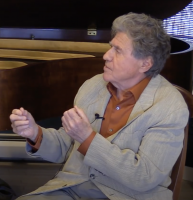
Contributions by the Interviewees
- Michel Arrignon
- Paolo Beltramini
- Alain Billard
- Francois Benda
- James Campbell
- Philippe Cuper
- Alain Damiens
- Eli Eban
- Steve Hartman
- Sylvie Hue
- Gerald Kraxberger 1, 2
- Seunghee Lee
- Harri Mäki
- Heinrich Mätzener
- Ernesto Molinari
- Pascal Moraguès
- John Moses
- Thomas Piercy
- Robert Pickup
- Frédéric Rapin
- Milan Rericha
- Ernst Schlader
- David Shifrin
- Richard Stoltzman 1, 2
- Jérôme Verhaeghe
- Michel Westphal 1, 2, 3
This page describes the instrumental-technical possibilities of playing a single note or several neighboring notes in succession. There are also links to the chapters on Attack or Staccato. Playing several notes without articulation pauses is explained in the chapter Legato, as a variant of articulation.
The articulation determines the physical attack of a sound. This results in a direct relationship between articulation and Timbre. In a musical context, articulation is considered an important parameter for interpretation. See Stanley Drucker, interview with Edward Joffe.
Historical Sources
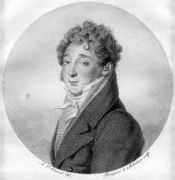
As the history of teaching literature shows, today’s method of articulating with a slight tongue movement on the reed was not always the most commonly used method. Joseph Fröhlich (1811) mentions articulating with the tongue, but prefers articulating "with the chest," connected with the double-lipped embouchure. In doing so, the player should cultivate playing with the reed "above the head" (touching the upper lip), since this provides the basis for a "firm full tone," and it is easier for the wind player to perform "more according to the correct singing method" and to give nuanced shades of expression ("zu nuancieren, alle Schattierungen im Ausdruck zu geben"). At the same time, referring to the same type of blowing as Fröhlich, Jean-Xavier Lefèvre (1802) required a "coup de langue" (beating the reed with the tongue) on every note. In order to achieve sufficient agility and endurance, the technique of articulating through a "jerky movement in the throat [glottis blow] or chest" ("faire agir par secousse, le gosier ou la poitrine") should be abandoned. On the term "coup de gosier," borrowed from the singing technique, see also Castil-Blaze, François Henri Joseph (1821) [1]
Johann Georg Heinrich Backofen (1803)[2] distinguished three different means of articulation: with the tongue, with the lips [by closing and opening the jaws], or with the throat. To achieve the best musical results, he recommends differentiated articulation with the tongue:
„Der Zungenstoss wäre also, so wie bei allen übrigen Blasinstrumenten, der beste, unerachtet er anfangs auf der Klarinette der schwerste ist, weil die Zunge durch den Schnabel, der den Mund ziemlich füllt, sehr geniert ist. So wie aber die vorerwähnten Klarinettisten gern alles schleifen (binden), so missbrauchen letztere auch die Zunge und tragen manchmal sanfte sangbare Stellen durch diesen Missbrauch rauh vor. Mich dünkt, nur rasche muntere Sätze wären für sie geeignet. Überhaupt muss der Charakter, der Geist, die Bewegung des musikalischen Satzes selbst zur besten Richtschnur dienen, wie ihn der Klarinettist in Ansehung der Zunge vorzutragen hat. Denn nicht bei jeder Note kann der Komponist anzeigen, wie er sie behandelt haben will, er muss auch etwas dem Gefühl des Musikers zutrauen.“
„Tonguing would be the best, as with all other wind instruments, but it is hardest to do on the clarinet because the reed is hindered by the mouthpiece, which fills the mouth. But just as the aforementioned clarinetists like to slide between (connect) everything, the latter abuse the tongue which can result in soft singable passages being performed in a rough way. It seems to me that only quick, lively movements would be suitable for them. In general, the character, the spirit, the movement of the music itself must serve as the best guideline for how the clarinetist should use their tongue to perform it. For the composer cannot indicate how he wants every single note to be treated; he must also have some confidence in the sensibility of the musician.“
Ferdinando Sebastiani (1886)[3] also points out the importance of varied types of articulation in connection with the reed position. Like Fröhlich, he is of the opinion that the potential for varying the articulation is greater when playing with the reed above (maxillary embouchure).
„Thus [in the case of mandibular embouchure] it is only possible to play the battuto, while picchettato, staccato and other colors that make up the value of the clarinet are not possible.”“
Iwan Müller (1826)[4] schreibt zur Ausführung der Artikulation der Zunge am Klarinettenblatt:
„Viele Personen haben die falsche Ansicht, zu glauben, ein schöner Ton und leichter Zungenstoss hänge davon ab, ob man das Blatt mit der der Ober- oder Unterlippe drücke [...] Dies kommt auf die einmal angenommen Gewohnheit an; ein schöner Ton und vortrefflicher Stoss ist auf beide Arten möglich und kein hindert das schöne Spiel.“
„Many people have the mistaken belief that a beautiful tone and light tonguing depend on whether the reed is pressed with the upper or lower lip [...] This depends on the players habit; a beautiful tone and excellent tonguing is possible in both ways and nothing hinders beautiful playing.“
Frédéric Berr (1836)[5] gibt uns in seiner "Methode" einen wertvollen Hinweis zur Ausführung der Artikulation der Zunge am Klarinettenblatt:
„Pour exprimer le bruit produit par ce coup de langue, on dit à tort, que celui qui exécute fait entendre les syllabes TU TU. On pourrait peindre l'action de la langue en disant qu'elle semble rejeter de la bouche un bout de fil lorsqu'elle dirige l'air dans l'instrument.»“
„The noise that the tongue makes when articulating on the reed is erroneously described as ‘Tu Tu’. One could paraphrase the action which the tongue performs when articulating on the reed as follows: The tongue moves in the same way as when it wants to expel a piece of thread from the mouth. This occurs at the same moment when the reed directs the air into the instrument.“
(Paolo Beltramini describes a similar exercise without an instrument)
Requirements
Breathing, Airflow, and Embouchure
Most of the methods of clarinet playing in use today describe articulation as a small downward movement of the tip of the tongue, away from the reed. Before this movement takes place, air pressure must be provided behind the reed for sound production. The mastery of a continuous air flow is therefore essential for artistic, clean, and varied articulation. The second, equally important prerequisite is a lead-in formation that is independent of the movement of the reed. Larry Guy (2016)[6] summarizes on behalf of many educators:
„Since good articulation is dependent upon air support and embouchure as much as the exact use of the tongue, an in-depth study of articulation should be preceded by a thorough review of its two-part foundation: air support and embouchure.“
Keith Stein (1958)[7] is convinced that articulation with the tongue can only be successfully learned and executed after the beginning and end of the tone, the attack and decay of the sound can be controlled exclusively by modifying the airflow. In the exercise described below, we will practice the sounding of the tone - not as diminuendo al niente, but as a tone that ends in the mf. This tone exercise is used to consciously use air to control the use of the tone and the end of the tone, while finding the best embouchure and the best position of the tongue and leaving it unchanged for an optimal sound result. Only when these two parameters are mastered should the tongue be used for articulation. Important: under no circumstances should the sound be stopped by closing the jaw or by closing the glottis. As can be seen, this is also an exercise for training the breath support.
„Set the tone in motion from a deeply-blown "hee" (with no aid from tongue). Then project the sound to the length of the clarinet. Release can now be started by reducing the amount of air flowing through the clarinet while fully maintaining the muscular push behind the breath until the air quantity is reduced beyond the point where it will vibrate the reed.“
All interviewees emphasize that know-how and control over airflow, breath support, and embouchure formation, independent of articulation, are indispensable prerequisites for good staccato. In practical terms this means that successful articulation is only possible on the basis of a beautiful legato ((Michel Arrignon, Pascal Moraguès, Harri Mäki, Frédéric Rapin 1 und 2, Jérôme Verhaeghe, Michel Westphal).
Sylvie Hue therefore lets her students play staccato passages in direct alternation with legato passages.
<bf>
Referring to his teacher Guy Deplus, Heinrich Mätzener points out a difficulty that must be recognized and mastered: while the muscles involved in air direction and breath support can and should develop a great deal of strength, the tongue should always move against the reed with extremely little pressure. Milan Rericha gives the same advice in connection with the sfz effect.
Voicing
A conscious shaping of the oral cavity (see also chapter voicing) determines the speed with which the air is supplied to the reed. A consciously controlled air speed is also an important factor for good attack and articulation:
Ernst Schlader: As in trumpet playing, the air speed of the clarinet plays an important role in reliable articulation. In order to achieve a clearer response, the tongue should pronounce a "de" or "te" instead of "da" or "ta," i.e. it should be placed in a higher and forward position.
Michel Arrignon and David Shifrin: when articulating with the tongue, it is important to strengthen not only the stability of the embouchure, but also stability of tongue position.
James Campbell: a clean sound can only be guaranteed with an air speed that corresponds to its pitch. The tip of the tongue must be pointing forwards and upwards before articulation or when a note is held on the reed.
Heinrich Mätzener: the tongue positions for articulation and the subsequent sounding tone are practically identical
Harri Mäki: the tongue must already get into in position for the following pitch when inhaling.
Tongue Tip on Reed Tip
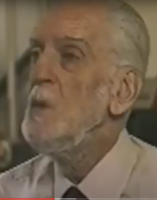
There are various doctrines on the question of how tongue and reed should connect. "Tongue tip on reed tip" is the concept of the Old French School. In the first half of the 20th century this method was advocated in the USA by Daniel Bonade(Daniel Bonade(1961)[8], and is still continued today by many American educators such as Larry Guy (2016)[9], David Pino (1980)[10] oder Michele Gingras (2017)[11]. The difficulty of this technique lies in the fact that the airflow requires relatively strong muscle activity, while the tongue must act extremely sensitively and with carefully measured force at the tip of the reed. The tip of the tongue should almost always enact piano at the tip of the reed, even if the air conduction exerts a forte dynamic (Heinrich Mätzener).
Joseph Allard (1910-1991), student of Gaston Hamelin (1884-1951), taught at the Juilliard School of Music (1956 - 1984) and gave many instructions on basic technique and sound production. Debra McKims (2000)[12] summarizes them in her dissertation, from which the following quotations show that Joseph Allard's reflections on articulation also include the differences between different languages, national schools, and their various associated mouthpiece/reed combinations:
„Whatever you do, don't say tu like the Americans, but say teu.
The French [teu]vowel maintains a high tongue, with the tip of the tongue dropping only to the level of the upper teeth. It also creates a small space at the front of the oral cavity. In the English pronunciation, the tongue drops well below the upper teeth and creates a larger cavity at the front of the mouth. Both pronunciations maintain a high placement with the back of the tongue. Hamelin of course, advocated the French syllable, which shaped the oral cavity into what he called a "forward coning" position. [...] In tongue position, "forward coning" is defined by an oral cavity that is small in the front and large in the back. In antithesis to this, Hamelin pointed to the accepted German school of clarinet playing: [...] "The Germans have a long lay in their mouthpieces and use heavy reeds. The pressure that's exerted is. .. well over an inch away from the edge of the reed so the mouthpiece goes quite far in the mouth. The tongue, in order to make room for the reed, has to go away from the roof of the mouth, leaving the front cavity of the mouth very large which forces the back of the mouth to be small". Hamelin referred to this as reverse coning.
The words and consonants which Allard used with students in this concept varied, but the end physical result remains the same - the back of the tongue touches the upper molars, the back of the oral cavity remains large, and the front of the oral cavity is narrow.““
Frédéric Rapin practices the same technique and articulates with the tongue as far up from the reed as possible. According to Rapin, the tongue’s task of shaping the oral cavity into a conical shape is a paradox. Steve Hartman attributes a focused sound and greater endurance in fast staccato passages to this constellation, with its flexibility and opening in the throat area and the tip of the tongue pointing upwards at the same time.
Michel Arrignon and Jérôme Verhaeghe consider the "tongue tip on reed tip" technique as the best method for clear, easy, and precise articulation. The result is a reflex-like, very small movement of the tongue away from the reed (see also Sylvie Hue, Heinrich Mätzener, Robert Pickup, Thomas Piercy, Milan Rericha).
François Benda recommends that this technique should first be studied as a basis and then modified according to individual morphology and musical context. Philippe Cuper shares this view.
Alicia DeSoto presents a very simple introduction to the technique "tongue tip on reed tip":
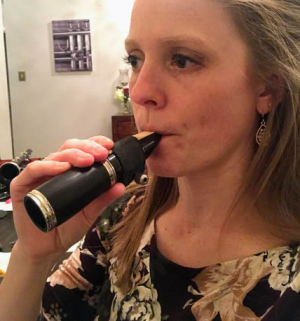
she has her students play a tone with only the mouthpiece and barrel, with the reed facing up. The reed is on the upper lip, the mouthpiece on the lower lip, as was customary in the early days of the clarinet and in Italy well into the 19th century. The blowing angle need slightly more adjustment the mouthpiece must be placed a bit further into the mouth than usual. If the vibration of the reed tickles too much on the upper lip, it is a sign that the embouchure is too loosely formed. The lips must be formed into an elastic cushion and fit more closely to the teeth. For support, the mouthpiece can also be moved a little more towards the base with the hand. Richard Stoltzman also gives this advice. This is also an exercise for shaping the embouchure. The tongue can only articulate at the tip of the reed if it is placed high enough in the oral cavity.
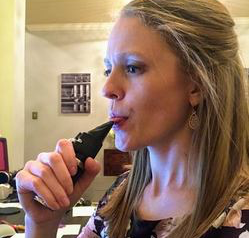
If one wants to articulate with the tongue too low or using too large an area of the reed, one will touch not the reed but, clumsily, the mouthpiece. In this way it is hardly possible to play a note. It does, however, sound a bit awkward. In order to become aware of the point of contact and the shape of the tongue Alicia DeSoto and Ernst Schlader both recommend opening the embouchure in front of the mirror at the moment of articulation and sticking out the tongue. Note the position, shape, and movement of "tongue tip on reed tip," turn the mouthpiece around, and articulate with the tongue in exactly the same way. This will improve intonation and clarity of articulation. The pitch to be played with mouthpiece and barrel is an F#1. This depends not only on the pressure of the embouchure, but also on the position of the tongue: to play F#1, the tongue must be directed forwards and upwards (see also Ernst Schlader).
Modifications and Variability of Articulation
To describe the articulation of several successive notes, the following signs are available in musical notation: a bow below or above the group of notes denotes legato, in which only the first note is articulated and the following notes are played smoothly together (until the 18th century the German term "schleifen" was also used for this). The non legato does not use signs under the notes, and progressing from tenuto ( - ) to portato (dots under the bow) to staccato (.) and finally ending at staccatissimo ('), the notes are progressively more separated: the articulation pauses between the notes become longer and the sound of the individual notes shorter. These types of notation must always be read and interpreted within the current context. In addition, the dynamic progression of the beginning of the tone, the tone duration and the end of the tone can be arranged differently. It is the performer's task to read the notation types differently depending on the musical context and to make them audible by using appropriate articulation. The opinions on which specific movements of the tongue should be assigned to the different notations are subject to a constantly changing aesthetic. Sylvie Hue plays staccato dots not short, but sounding; short, dry staccatos, as still demanded in the school of Ulysse Delécluse, are out of fashion today. Like Heinrich Backofen (1803)[2], Carl Baermann (1861)[13] also emphasizes the artistic-interpretative significance in the examination of different types of articulation and summarizes it in the following words:
„Text Diese angegebene Stricharten erleiden wieder unter sich verschiedene Modifikationen, welche durch den Charakter der vorzutragenden Stellen bedingt und mehr oder weniger von dem feinen Gefühl und Verständnis des Vortragenden abhängig sind. Der Schüler halte sich jedoch genau an die vorgeschriebenen Bezeichnungen und mache sich zum festen unumstösslichen Grundsatz, alles auf möglichst vollkommene Art zu bringen, keinen Fehler hingehen zu lassen und vor allem nie mit sich selbst zufrieden zu sein, denn die Kunst ist lang und das Leben ist kurz.““
„These various indications of articulation themselves undergo various modifications, conditioned by the character of the passages to be performed, and dependent to a greater or lesser extent on the sensitivity and understanding of the performer. The student, however, keeps strictly to the prescribed terms and makes it a firm, unalterable principle to do everything in the most perfect way possible, not to let any mistake go and above all never to be satisfied with himself, because art is long and life is short."“
Ernst Schlader and François Benda recommend the use of various consonants (de, di, da, te, ti ta ,the, ze li ni ,etc.). Joseph Allard differentiates the position of the tongue when touching the reed and during the sound of a tone as he describes the process of tongue movement as "diü." (saying "i" the tongue touches the reed, forming the wovel "ü" the tongue is slightly pulled back).
[James Campbell#Articulation and Staccato|James Campbell]] and Michel Westphal recommend "just below the tip of the reed with just behind the top of the tip of the tongue," but like Philippe Cuper and Sylvie Hue, they are convinced that individual morphology ultimately determines where the tongue touches the reed.
David Shifrin, John Moses and Thomas Piercy modify the point of contact depending on the musical context "the tongue touches the reed up to 2mm below the tip of the tongue." The size of the area touched by the tongue can also change depending on the musical context and the desired effect.
Frédéric Rapin also establishes a relationship between the speed of the détaché and the point of contact on the reed: the faster the détaché, the further from the tip of the reed the tongue touches the reed.
François Benda pursues the same goals and chooses different points of contact between the tongue and the reed depending on the musical expression. The shorter the tone, the more surface of the reed and tongue are in contact. For the articulation to be light, the tip of the tongue must only touch the tip of the reed. He also recommends adjusting the blowing angle according to individual morphology and tooth position in order to achieve a good result.
Eli Eban differentiates the point at which the tongue touches the reed. By articulating just below the tip of the reed, the tone can be finished more clearly if a "rebound" of the reed is not desired. As a former student of Yona Ettlinger, he also used the technique of releasing the reed vibration with a slight delay only after the vibration of the reed has been felt on the tongue. This is a good exercise for sensitizing oneself to the pressure of the tongue on the reed and being able to apply this sensitivity again at the reed base for the fading of a tone (see also The Fading of a Tone)
Pascal Moraguès encourages attention to the musical context and using all suitable articulation techniques. In addition, the acoustics of the room and the size of the concert hall, as well as texture and instrumentation must be considered. In order to achieve the appropriate shading, different points of contact of the tongue on the reed should be chosen: touching the reed at the very tip, a little further down, or even just one corner of the reed with the tongue can produce the desired results.
The Fading of a Tone
Like the beginning, the fading of each note should be artistically designed. Leopold Mozart (1756) describes this in his Violin Tutor:
„Jeder auch auf das Stärkste ergriffene Ton hat vor sich eine kleine obwohl kaum merkliche Schwäche vor sich: sonst würde es keinen Ton, sondern nur ein unangenehmer und unverständlicher Laut seyn. Eben diese Schwäche ist an dem Ende indes Tones zu hören. Man muss also den Geigenbogen in das Schwache und Starke abzuteilen, und folglich durch Nachdruck und Mässigung die Töne schön und rührend vorzutragen wissen.““
„Every note that is struck, even the strongest, is preceded by a small if hardly noticeable weakness; otherwise there would be no note, but only an unpleasant and incomprehensible sound. It is precisely this weakness that can be heard at the end of a tone. One must therefore divide the violin bow into the weak and the strong, and consequently know how to play the tones beautifully and touchingly through emphasis and moderation.”“
Alain Damiens takes up this thought and dampens the vibration of the reed with a touch of the tongue. In this way, the resonance of a string pizzicato can be imitated in the body of the instrument. Pascal Moraguès also uses this technique. Especially when playing with strings, he imitates their détaché. He lets the reed vibrate further by only touching it with the tongue at one corner. This way the reed has enough free space to continue vibrating. This effect is also used by Thomas Piercy.
Heinrich Mätzener also practices a "springy" airflow to control the fading of the sound.
François Benda uses a different embouchure here, similar to that used by horn players: the sound is stopped by touching the tongue on the reed.
And Richard Stoltzmanuses the tongue not only to articulate a tone and let it fade away in a variety of ways. He compares the tongue to the bow of the string player, with which the music is not only articulated but also phrased.
Jérôme Verhaeghe takes yet another approach and tries to imitate the attack and articulation of all other woodwind instruments and the musical style practiced in other language cultures.
The Movement Sequence of Articulation
Larry Guy (2016) describes the movement sequence needed for articulation as follows[6]]: 1. Form the embouchure, with a long chin, lips hugging the teeth. 2. Take a deep breath. 3. Insert the mouthpiece, with reed sliding against the firm lower lip. 4. Touch the tongue to the reed. 5. Blow a little air, and feel it behind the tip of the tongue, there will be no sound. 6. Drop the tongue down a very small distance from the reed to start the sound. 7. Think of the syllable "tu" Depending on the musical contrasts, Heinrich Mätzener combines the air direction with the movement of the tongue or the type of articulation.
And Only the Tip of the Tongue Moves!
David Shifrin and John Mosesmake sure that the tongue never falls back into the throat after articulation, but always remains as close as possible to the tip of the reed, i.e. that it performs the smallest possible movement. The strength and pressure the tongue exerts on the reed can be controlled better with a small movement. In addition, pointing the tip of the tongue forwards and upwards accelerates the airflow and thus improves the attack.
Alain Damiens, Sylvie Hue, Steve Hartman, Michel Westphal and Heinrich Mätzenerpoint out that with this articulation technique, only the tip of the tongue moves, and then only the smallest possible distance. The back part of the tongue opens and forms the interior of the oral cavity and, whether a note is being held or articulated, remains in a deep position, opening the throat. From an anatomical point of view, this involves the activation of Musculus mylohyoideus the mylohyoid muscle (see also John Allard). Jérôme Verhaeghe lets his students touch the throat with their own hand during the détaché to ensure that that area (the back part of the tongue) does not move. This ensures that the throat remains open even during the articulation of the tongue, and that the air pressure is constantly directed towards the reed.
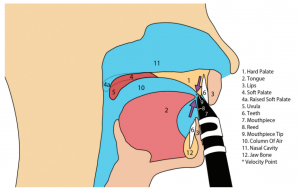
In Keith Stein’s (1958)[7] words:
„Good tonguing, however, results from tongue placement well up front nearly touching the reed, from which position it does not move away either in action nor in repose. The tongue tips falls away just enough to clear the vibrating reed and does not operate forward and backward like piston. The distance or orbit which the tongue tip moves is so slight that it feels more like a muscular "tish" than an actual movement.“
Ron Odrich (2017)[15] brings an additional aspect into play: the reed can also be touched with the underside of the tip of the tongue.
Further Variations of Articulation
Michel Arrignon, Thomas Piercy: a tone can only be played by the airflow and without reed articulation. Depending on the musical context, this can produce very good results.
Heinrich Mätzener): A short successive combination of "articulation only with air" and "tongue articulation" ("hi"-"di") can produce good results as a quick articulation of a group of two.
Alain Damiens: The tongue does not touch the reed, but "bumps" against the lower lip, which then stops the vibration of the reed through increased pressure. He had learned this type of articulation from his first teacher, but it only later became a subject in class, requiring relearning at that point. Thomas Piercy also uses this technique for special effects to separate tones but certainly not to produce blowing noises.
In order to master delicate tonal elements in the upper clarinet register, the tip of the tongue can touch only one corner of the reed tip. Eli Eban and Pascal Moraguès practice this technique.
Alain Billard: Closing the lower jaw in order to dampen the vibration of the reed with the embouchure - strictly rejected in many schools - can also be useful, especially for bass and contrabass clarinet.
James Campbel also mentions the possibility of articulation by waving the tongue along the tip of the reed from left to right (see also Articulation types, Kornel Wolak)
Anchor Technique
Peter Hadcock (1999)[16] describes the technique of leaning the tongue against the lower row of teeth, or the lower lip, and articulating with a point on the back of the tongue on the reed. Since the tongue can "lean" against the reed, it is easier to articulate very quickly; the tongue would make less blowing noise since it does not hit the tip of the reed; and finally the tongue would "not stand in the way" of the airflow. Peter Hadcock questions the exclusive teaching of the "tongue tip on reed tip" technique, since there are always very good results even with other types of articulation.
Alain Billard and Gerald Kraxberger play successfully with the anchor technique.
Gerald Kraxberger points out how decisive it is when the course is set for one technique or another. After many years of practice, it is very hard to change the anchor technique.
The anchor technique is more natural for many beginners and is therefore used intuitively, but in many cases it goes unnoticed by the teachers and is often the reason for cumbersome articulation. For a good result, even with the back of the tongue, only a small area of the reed should be touched.
Eli Eban sees no possibility of combining the anchor technique with a vocalization-oriented playing style. Playing based on vocalization aims at modifying the air speed by variable reed positions and thereby optimizing attack, intonation, and timbre depending on the pitch. David Shifrin recommends – but does not insist – that new students who use the anchor technique relearn it. Harri Mäki would not recommend relearning to a student who plays successfully with the anchor technique.
Attack
Ultimately, the know-how of reliable tone production and problem-free attack of individual notes is an important prerequisite for developing rhythmic conciseness, richly varied articulation, and dynamically flexible playing. The literature for clarinet presents the following challenges:
- Attack can be performed reliably at any pitch and register and at any dynamic level.
- The manner of attack - harder or softer, "dal niente" (beginning from nothing) or with a certain sharpness - must be variable and adaptable to the character of the piece.
- Intonation and timbre should already be stable at the moment of attack and not only settle down as the tone progresses.
Didactic Process
Keith Stein[7] demands the isolated learning and mastery of the following parameters of clarinet technique before reed articulation can be used successfully:
- Embouchure
- Airflow
- Breathing#Breath Support
- Embouchure line
- Embouchure pressure and selection of the most favorable blowing angle
- Reed and Mouthpiece, selection and maintenance, reed cutting and balancing
- Awareness of voicing in terms of tongue shape, position, and activity, and of the shaping of the throat and soft palate
A "dal' nietete" attack is considered a specific characteristic of the clarinet. Ron Odrich (2017)[17] gives the airflow the fastest possible speed by raising the position of the tip of the tongue just in front of the reed. At the same time the throat remains open. In this model he refers to Leonardo da Vinci, Daniel Bernoulli, and Giovanni Battista Venturi. This playing technique can be understood with a simple experiment: if the position of the tip of the tongue changes from low (touching the one under the row of teeth) to high (directed forwards and upwards and almost touching the tip of the reed) when a tone is blown, the attack is also in ppp (see also Jerry Rife (2019), "...about sound production"[18])).
References
- ↑ Dictionnaire de musique moderne, Castil-Blaze, François Henri Joseph. 1821. Dictionnaire de musique moderne. Tome 1 Tome 1. Paris: Magasin de Musique de la Lyre Moderne.
- ↑ 2,0 2,1 2,2 Backofen, Johann Georg Heinrich, and Karl Ventzke. 1986. Anweisung zur Klarinette nebst einer kurzen Abhandlung über das Basset-Horn. Celle: Moeck eproint der Asigabe Leipzig 1803)
- ↑ 3,0 3,1 Ferdinando Sebastiani: Metodo Progressivo per Clarinetto. Napoli 1886, S.7. Zitiert nach Adriano Amore: Ferdindando Sebastiani (1803-1860) und die Neapolitanische Klarinettenschule, in das rohrblatt, Juni 2008, S.58-60.
- ↑ 4,0 4,1 Müller, Iwan. 1826. Anweisung zu der neuen Clarinette und der Clarinette-Alto: nebst einigen Bemerkungen für Instrumentenmacher ; [Op. 24]. Leipzig: Hofmeister. [1]
- ↑ Frédéric Berr: Méthode complète de Clarinette adoptée au Conservatoire de Musique de Paris, p 14 Paris 1836.
- ↑ 6,0 6,1 6,2 Guy, Larry. 2016. Articulation development for clarinetists: including exercises and passages from the orchestral and chamber music repertoire, with a demonstration CD
- ↑ 7,0 7,1 7,2 7,3 7,4 Stein, Keith. 1958. The art of clarinet playing. Evanston, Ill: Summy-Birchard [2]
- ↑ Bonade, Daniel. 1962. The clarinetist's compendium: including method of staccato and art of adjusting reeds. Kenosha, Wis: Leblanc Publications. [3]
- ↑ Guy, Larry. 2018. Articulation development for clarinetists: including exercises and passages from the orchestral and chamber music repertoire, with a demonstration CD.
- ↑ David Pino: The Clarinet and Clarinet Playing. Dover Publications, Mineola, New York 2014. Tonguing, p.150.[4]
- ↑ Gingras, Michèle. 2017. Clarinet secrets: 100 performance strategies for the advanced clarinetist. New York, London. p.13 [5]
- ↑ 12,0 12,1 McKim, Debra Jean. 2007. Joseph Allard: his contributions to saxophone pedagogy and performance.[6]
- ↑ 13,0 13,1 Baermann, Carl (1861): Vollständige Clarinett-Schule: von dem ersten Anfang bis zur höchsten Ausbildung des Virtuosen; Erster Theil Op.63. Johann André, Offenbach/Main 1861. Bayerische Staatsbibliothekdigital
- ↑ Leopold Mozart Violinschule, herausgegeben von der Internationalen Stiftung Mozarteum, Salzburg Das fünfte Hauptstück.§3 {2. Februar 2021}
- ↑ Odrich, Ron (2017). Science in the Art of the Legato. The Clarinet 44/4 (September 2017)
- ↑ Hadcock, Peter, Bruce Ronkin, Aline Benoit, and Marshall Burlingame. 1999. The working clarinetist: master classes with Peter Hadcock. Cherry Hill, NJ: Roncorp, p. 166
- ↑ Odrich, Ron (2017). Science in the Art of the Legato. The Clarinet 44/4 (September 2017) [7]
- ↑ Rife, Jerry (2019). An interview with Ron Odrich. The Clarinet 47/1 (December 2019)[8]
